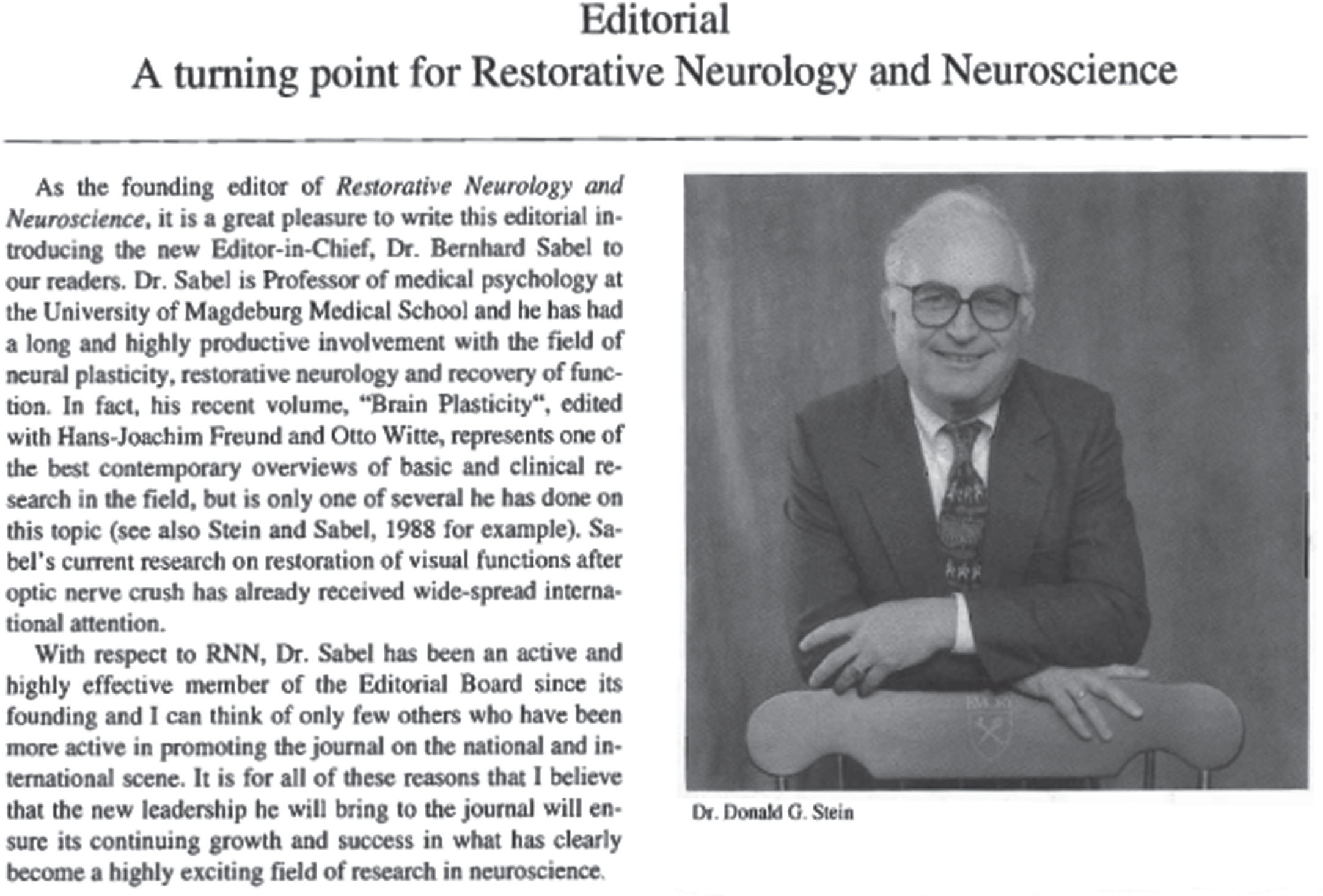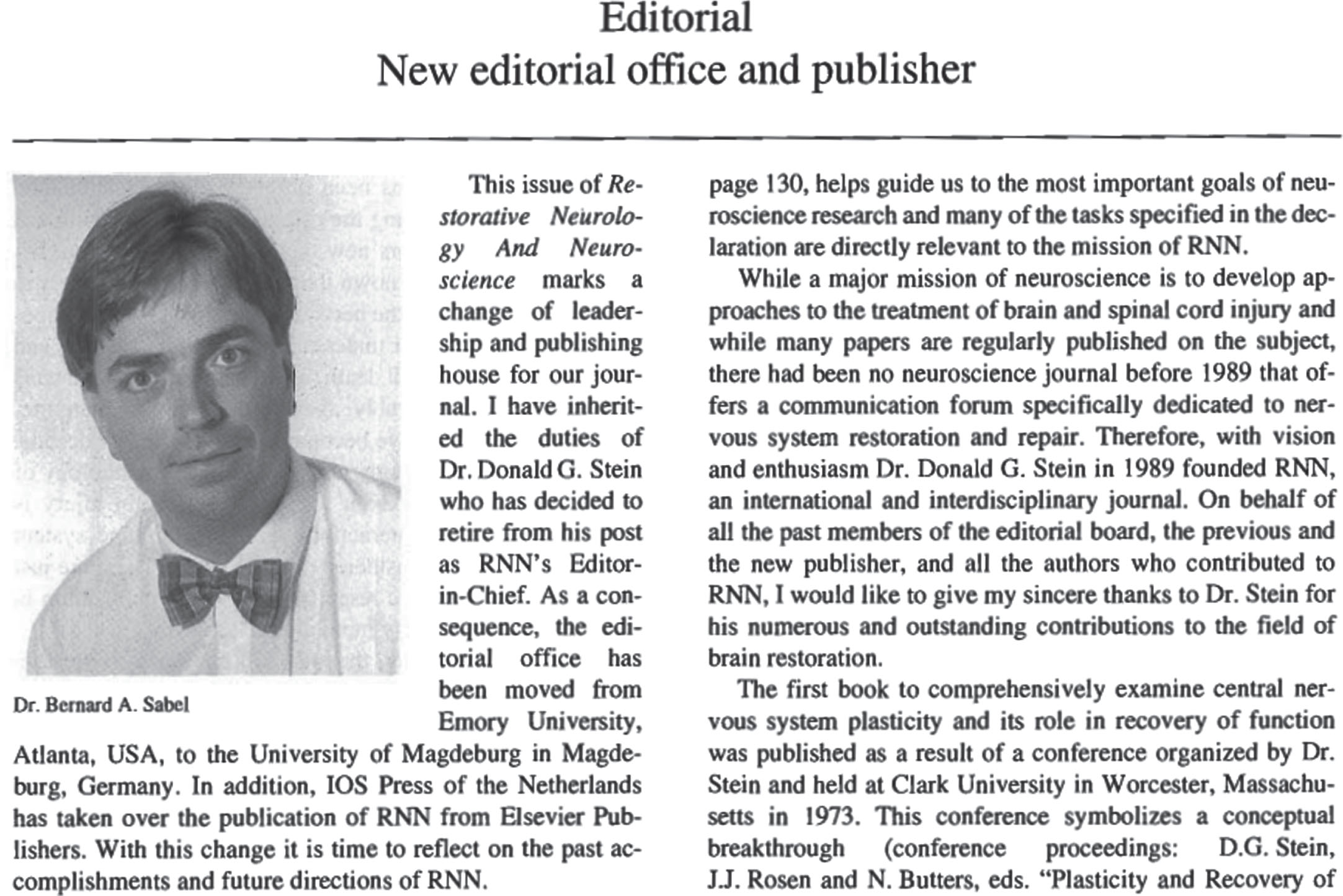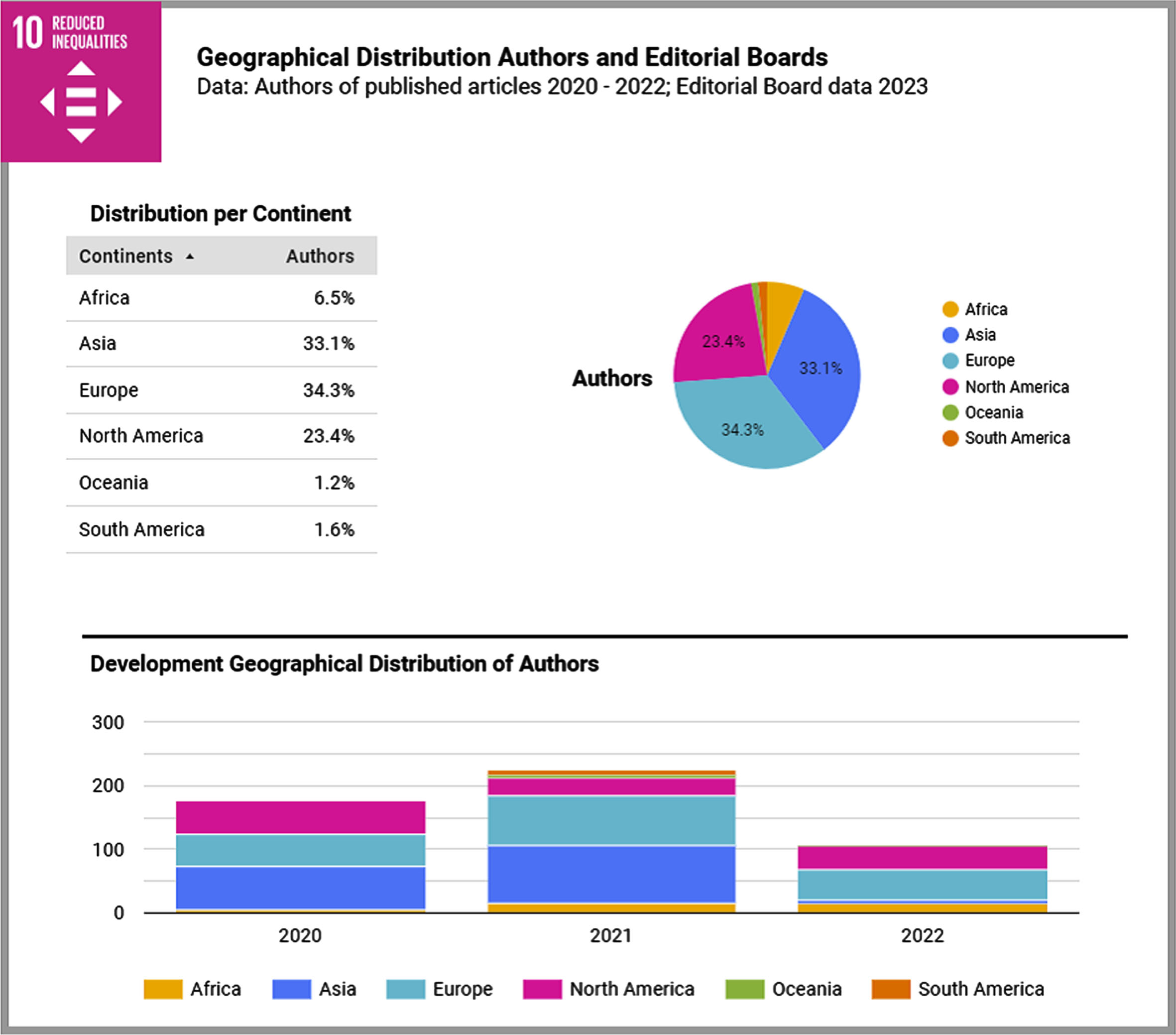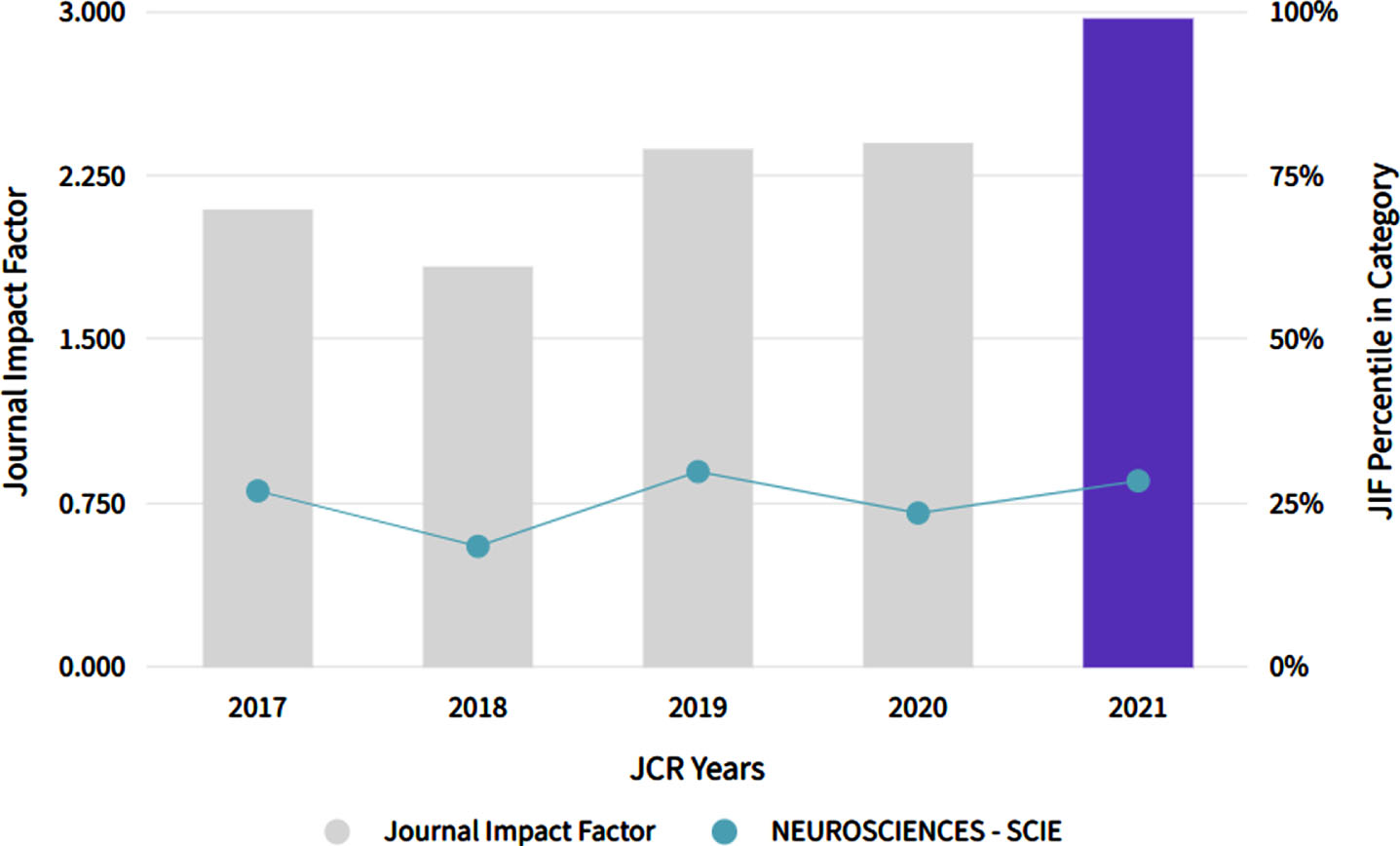Restorative Neurology and Neuroscience: Celebrating the 40th volume of an academic journal
Abstract
Since the first issue of the academic journal Restorative Neurology and Neuroscience (RNN) was published in 1989, 40 volumes with a total of 1,550 SCI publications have helped advance basic and clinical sciences in the fields of central and peripheral nervous system rescue, regeneration, restoration and plasticity in experimental and clinical disorders. In this way RNN helped advance the development of a range of neuropsychiatric intervention across a broad spectrum of approaches such as drugs, training (rehabilitation), psychotherapy or neuromodulation with current stimulation. Today, RNN remains a focused, innovative and viable source of scientific information in the neurosciences with high visibility in an ever changing world of academic publishing.
1Introduction and historic account
Restorative Neurology and Neuroscience (RNN) was first published 34 years ago, in 1989, by the academic publisher Elsevier (Amsterdam, The Netherlands) under the auspicious guidance of Donald G. Stein, PhD, at Emory University (Atlanta, USA). He birthed RNN and starting-up its early growth phase (see editorial in Fig. 1).
Fig. 1
The Editorial where Editorship was turned over from the founder, Donald G. Stein to Bernhard A. Sabel.

After 10 volumes were published, the journal changed “homes” in two ways: firstly, RNN was acquired by another academic publisher, IOS-Press, located also in Amsterdam, and secondly, with Volume 11, published in 1997, the Editorship and editorial office was handed over to Bernhard Sabel, PhD, at Otto-v.-Guericke University of Magdeburg (Magdeburg, Germany) (see editorial Fig. 2). After 1998, when the Editor-in-Chief visited the National Library of Medicine in Washington, some technical adaptation were made and RNN was accepted for listing in the biomedical search engine “Pubmed.gov”and indexing to receive the all important “Impact Factor” in the Web of Science which has been solid in the in the past years. Since then, RNN has had a good traction in the academic publishing domain and is now abstracted/indexed in all major search engines (Table 1).
Fig. 2
Editorial introducing Bernhard A. Sabel as new editor-in-chief in 1997.

Table 1
RNN-publication displays in search engines
| Academic Search |
| Cabell’s Guide or Directory |
| Chemical Abstracts Service (CAS) |
| CSA Illumina |
| e-psyche database |
| EBSCO DatabasesElsevier |
| BIOBASEEmbase |
| MEDLINE |
| Microsoft Academic Search |
| OA @ PubMedCentral |
| Prous Science Integrity |
| PsycINFO |
| PubMed |
| SciVerse |
| Scopus |
| Ulrich’s Periodicals Directory |
| Web of Science: Journal Citation |
| Reports/Science Edition |
| Web of Science: Science Citation |
| Index Expanded (SciSearch®) |
RNN has since become a member of the “Neuroscience Peer Review Consortium (NPRC)”, a group of >70 neuroscience journals which collaborate under the auspices of the Society for Neuroscience. NPRC was started in 2007 by neuroscience journal editors and publishers at the Annual Meeting of the Society for Neuroscience (USA). It provides a system permitting authors whose manuscript received supportive reviews at a member journal but was rejected (e.g. for lack of scope, sufficient novelty or merit etc.) could be resubmitted (after revision) to another journal so to speed up its publication.
2RNN editorial policy
Since the time of its inauguration, the journal has always maintained an interdisciplinary approach of including all fields of science relevant to the topic of nervous system restoration, recovery, repair, and plasticity. It covers a broad range of scientific field which contributed to RNN publishing across the whole spectrum of methodologies of basis and clinical sciences.
From the basic science perspective, RNN published papers in the fields of neuroprotection, neuromodulation, regeneration, and plasticity early and late in life using methods ranging from molecular biology, to in vitro, and “whole system” animal experiments. From the clinical perspective RNN focusses of neurology, neuropsychology and rehabilitation, with publications covering studies in human experimental psychology, natural (spontaneous) plasticity and recovery in patients with different peripheral and central nervous system disorders, including clinical trials of neurological rehabilitation training, neuromodulation and even vision restoration. It is this broad spectrum of interdisciplinary publishing which makes RNN unique. Since its inception, and still today, all manuscripts are sent out for blind peer review to editorial board members or outside reviewers.
RNN‘s philosophy is expressed in its Aims and Scopes as listed on its website (https://www.iospress.com/catalog/journals/restorative-neurology-and-neuroscience)
“Aims & Scope: This interdisciplinary journal publishes papers relating to the plasticity and response of the nervous system to accidental or experimental injuries and their interventions, transplantation, neurodegenerative disorders and experimental strategies to improve regeneration or functional recovery and rehabilitation. Experimental and clinical research papers adopting fresh conceptual approaches are encouraged. The overriding criteria for publication are novelty, significant experimental or clinical relevance and interest to a multidisciplinary audience”.
3RNN publication record
This track record began with first RNN contribution by Dr. Fred Seil describing how a tissue culture system can be used to study neuroplasticity (Fig. 3). Since then, the publishing field has undergone considerable transformation. In the first years of RNN life, articles were typically published in actual (paper-printed) journals subscribed by libraries. Nowadays they still exist, but because of the availability of downloads in the internet and “open access” (OA) publishing at no cost for the users (including the general public), anyone can read them and anywhere – even on the smart phone. This evolution of academic publishing has influenced editorial work tremendously. On the one hand, it made science more accessible to the public, and, on the other hand, this opened the door for a massive growth which does not match the true progress in science. As of 2023, RNN has published more than 1.550 PubMed-listed articles (Fig. 4), and the geographical distribution of RNN authors in 2020 and 2021 shows a roughly similar contribution by authors from North-America, Europe, and Asia (Fig. 5).
Fig. 3
First article published in RNN [RNN-1989, vol. 1, no. 1, pp. 1-11].
![First article published in RNN [RNN-1989, vol. 1, no. 1, pp. 1-11].](https://content.iospress.com:443/media/rnn/2022/40-4-6/rnn-40-4-6-rnn239003/rnn-40-rnn239003-g003.jpg)
Fig. 4
RNN publication rate per year since its beginning in 1989.

Fig. 5
Geographic distribution of RNN authors.

Nevertheless, to appreciate the dynamics of the RNN publication record, let us consider different metrics which are commonly accepted surrogates of successful publishing: (i) the number of journal articles, (ii) the impact factor, and (iii) the number of views of articles in digital/social media. Of course, these numbers are influenced by different factors such as the publication media, print, or online-access by subscription, open access (for free) and social media. In a way, the history of RNN was influenced by, and also reflects this fundamental transformation in academic publishing over the last decades, influencing both journal content and efforts and responsibilities of its editorial office.
Regarding the number of publications, RNN is a rather small journal with an output has fluctuated over the years with an average of 50 publications per year (see Fig. 4, Table 2). However, in the last two years the number of RNN publications has markedly declined. There are three main reasons for this development: (i) heavy competition by new academic publishers on the block and a flood of newly emerging journals that take advantage of the Open Access (OA) marketing strategy; (ii) the introduction of strict policies of the RNN editorial office to reject papers which are of questionable quality, including many cases of presumed “fake” manuscripts which show signs of fraudulent experimentation, fake production by “paper mills”, or manuscripts which are obviously out of scope. The net effect was a marked drop in RNN publication number with a current acceptance ratio of approx. 30%, roughly half the normal rate starting in 2020. In fact, fake publishing has become an issue that the entire community of scientists and academic publishers are struggling with at this time, and fake publications have become a serious threat to the permanent scientific record (Sabel et al., 2023). (iii) Finally, the COVID pandemic lockdowns caused experiments and laboratories/institutions to be closed down which delayed results and their subsequent submission/publication.
Table 2
RNN publishing rate by submissions and rejections
| Year | Submissions | Published | Acceptance ratio | Impact Factor (IF) | Article Views |
| 2012 | 85 | 43 | 0,51 | 2,93 | – |
| 2013 | 80 | 63 | 0,79 | 4,18 | – |
| 2014 | 106 | 64 | 0,60 | 2,49 | – |
| 2015 | 142 | 76 | 0,54 | 2,66 | – |
| 2016 | 83 | 76 | 0,92 | 2,53 | 27,494 |
| 2017 | 93 | 51 | 0,55 | 2,10 | 25,677 |
| 2018 | 86 | 60 | 0,70 | 1,84 | 23,434 |
| 2019 | 92 | 48 | 0,52 | 2,38 | 22.909 |
| 2020 | 154 | 38 | 0,25 | 2,41 | 25.275 |
| 2021 | 108 | 33 | 0,31 | 2,98 | 25.448 |
| 2022 | 49 | 15 | 0,31 | TBD | 32.135 |
| Mean | 98,0 | 51,5 | 0,54 | 2,71 |
4Scientific impact and public awareness
The second metric, the Impact Factor, is viewed by the scientific community as the key criterion of the “quality” of a journal and its articles. In earlier times, and still today, the cumulative impact factor metric is used by many individuals and organizations to evaluate the productivity and impact of the authors and – together with the publication number – it can make or break scientific careers. The track-record of RNN with regard to the impact factor is rather solid (Fig. 6) given the size of the journal and the highly specific scientific scope in the field of brain restoration. As Table 2 shows, the impact factor of RNN typically ranges from IF 2-3 (average: 2.7), reaching its top score of 4.2 in the year 2013.
Fig. 6
RNN Impact Factor development over recent years.

Of course, the number of citations is the most commonly accepted indicator of a journal's “quality” of content. Overall RNN publications were cited 35,446 times with a 24 average citation average per article. Table 3 and the list of the top five citations (Kwakkel et al., 2004; Boggio et al., 2007; Nitsche & Paulus, 2011; van Eldik & Wainwright, 2003; Reiber, 2003) articles receiving most citations. In 2022 alone the journal had 2,798 citations.
Table 3
Top Citations and article view statistics
| Authors | RNN publication topic | Citations |
| Kwakkel et al. | Understanding the pattern of functional recovery after stroke… | 504 |
| Boggio et al. | Noninvasive brain DC stimulation ssociated with motor function… | 424 |
| Nitsche &Paulus | Transcranial direct current stimulation –Update 2011 | 409 |
| Van Eldik &Wainwright | The Janus face of glial-derived S100B… | 331 |
| Reiber | Proteins in cerebrospinal fluid and blood… | 285 |
| Authors | RNN publication topic | Views |
| Buma et al. | Understanding upper limb recovery after stroke | 8,514 |
| Tass et al. | Counteracting tinnitus by acoustic coordinated reset neuromodulation | 7,712 |
| Sabel et al. | Non-invasive brain microcurrent stimulation therapy of long-COVID… | 7,157 |
| Ditzen & Heinrichs | Psychobiology of social support: The social dimension of stress buffering | 6,478 |
| da Silva Cameirão et al. | Virtual reality based rehabilitation speeds up functional recovery… | 6,108 |
Unlike in the early RNN years, nowadays journals are also judged by visits in digital/social media, i.e. how often content was viewed or downloaded by users via digital information platforms such as google search engines, pubmed.org etc (Table 1). The good news is that the number of “views” (=public awareness) of RNN content has risen markedly in recent years reaching 32,135 views in 2022 alone (Table 2).
The most popular (viewed) article published in the last 10 years is a review article by Buma et al. (2013) on “Understanding upper limb recovery after stroke” and that by the editor Sabel et al. (2021) on “Non-invasive brain microcurrent stimulation therapy of long-COVID-19 reduces vascular dysregulation and improves visual and cognitive impairment”.
Very often the popularity of an article is helped by the fact that it is published in an open access format and RNN does provide this option. Also, papers that receive a press release can receive a substantial boost because the summary of the results shared in lay language reaches the general public.
5Editorial analysis and conclusions
To understand the factors responsible for growth dynamics and to get insight about the recent decline of the RNN publication rate since 2020, we carried out an analysis of RNN editorial parameters to evaluate the editorial decision process and the authors' country of origin. The geographical location of authors as shown in Fig. 5 indicates for 2020 a similar contribution by authors from North-America, Europe, and Asia. However, in 2021 a stricter reviewing procedure was introduced by the Editor-in-Chief. He started using detection methods to red-flag (checking signs) of potential fake-publications suspected to be fabricated by so-called “paper-mills”. “Paper-mills” offer their “editing” services on the internet with the argument to help students and scientists increase their publication record by preparing fake data manuscripts using fake data, fake images and fake text generated by artificial intelligence. This action was prompted by the increasing awareness that fake science publishing has become a serious problem in recent years (particularly after 2012) especially in journals with medium impact factor, their prime target. This problem was described in an editorial by Sabel & Seifert (2021), and the prevalence of suspected fake articles was subsequently studied in greater detail by Sabel et al. (2023) who estimated that more than 100,000 publications per year are suspicious. The consequence of this stricter policy was a marked increase in outright rejections (without further review) and therefore fewer published papers from authors located in Asia (mostly China).
Yet, another factor can also explain the declining publication rate: the increasing number of academic journals competing for manuscripts with aggressive internet marketing, which – together with the hundreds of thousands potential fake publications per year – increased the publication output to unprecedented levels that probably no longer reflect the true global growth of scientific discovery. It seems as if scientific publications are now viewed as instruments to communicate scientific “truth” one can be proud of. But it rather seems they slowly morph to become commodities designed to generate revenues for “paper mills” and (some, hopefully not all) academic publishers in the Open Access world.
The future health and growth of RNN will depend on how well the publication number can return to normal levels despite the pollution of the permanent scientific record by fake manuscripts. This is the challenge that the future editorial office will have to face. After 25 years of serving as the Editor-in-Chief the time has come that new talent runs the journal in the years to come in an academic world that is being transformed at breathless speed. Because the topic of neuronal restoration and recovery is one that deserved more attention in our aging societies where diseases of the peripheral and central nervous system are on the rise, I believe RNN has a bright future in the years to come. It is, however, time for the torch of editorship to be passed on to a new editorial team in an academic publishing world that has rapidly changed in just a few years.
Finally, I wish to take this opportunity to write some words of thanks for their invaluable support of my team, especially Steffi Matzke and also Dr. Sylvia Prilloff at the Institute of Medical Psychology of the University of Magdeburg for their always effective a supportive role in managing the editorial process. My thanks also to the IOS Press team, especially Rasjel van der Holst and Einar Fredriksson, for their trust and friendship over more than two decades. Finally, last but not least, all this work would not be possible without support of my wife Kornelia who was always patient and understanding for the long extra working hours I put into this editorship. Together with more than the authors of 1,500 publications, I hope we made the science of brain restoration and plasticity more visible and clinical care a bit more effective so that the world of the handicapped people becomes a better place to live in.
References
[1] | Boggio, P. S , Nunes, A , Rigonatti, S. P , Nitsche, M. A , Pascual-Leone, A & Fregni, F. ((2007) ) Repeated sessions of noninvasive brain DC stimulation is associated with motor function improvement in stroke patients, Restorative Neurology and Neuroscience 25: , 123–129. |
[2] | Buma, F , Kwakkel, G & Ramsey, N. ((2013) ) Understanding upper limb recovery after stroke, Restorative Neurology and Neuroscience 31: , 707–722. |
[3] | da Silva Cameirão, M , Bermúdez I Badia, S , Duarte, E & Verschure, P. F. M. J. ((2011) ) Virtual reality based rehabilitation speeds up functional recovery of the upper extremities after stroke: A randomized controlled pilot study in the acute phase of stroke using the rehabilitation gaming system, Restorative Neurology and Neuroscience 29: , 287–298. |
[4] | Ditzen, B & Heinrichs, M. ((2014) ) Psychobiology of social support: The social dimension of stress buffering, Restorative Neurology and Neuroscience 32: , 149–162. |
[5] | Kwakkel, G , Kollen, B & Lindeman, E. ((2004) ) Understanding the pattern of functional recovery after stroke: Facts and theories, Restorative Neurology and Neuroscience 22: , 281–299. |
[6] | Nitsche, M. A & Paulus, W. ((2011) ) Transcranial direct current stimulation–update, Restorative Neurology and Neuroscience 29: , 463–492. |
[7] | Reiber, H. ((2003) ) Proteins in cerebrospinal fluid and blood: Barriers, CSF flow rate and source-related dynamics, Restorative Neurology and Neuroscience 21: , 79–96. |
[8] | Sabel, B. A , Knaack, E , Gigerenzer, G. & Bilc, M. ((2023) ) Fake Publications in Biomedical Science: Red-flagging Method Indicates Mass Production. medRxiv, The Preprint Server for Health Sciences. |
[9] | Sabel, B. A & Seifert, R. ((2021) ) How criminal science publishing gangs damage the genesis of knowledge and technology – a call to action to restore trust, Naunyn-Schmiedeberg’s Archives of Pharmacology 394: , 2147–2151. |
[10] | Sabel, B. A , Zhou, W , Huber, F , Schmidt, F , Sabel, K , Gonschorek, A. & Bilc, M. ((2021) ) Non-invasive brain microcurrent stimulation therapy of long-COVID-19 reduces vascular dysregulation and improves visual and cognitive impairment, Restorative Neurology and Neuroscience 39: , 393–408. |
[11] | Tass, P. A , Adamchic, I , Freund, H. -J , von Stackelberg, T. & Hauptmann, C. ((2012) ) Counteracting tinnitus by acoustic coordinated reset neuromodulation, Restorative Neurology and Neuroscience 30: , 137–159. |
[12] | Van Eldik, L. J. & Wainwright, M. S. ((2003) ) The Janus face of glial-derived SB: Beneficial and detrimental functions in the brain, Restorative Neurology and Neuroscience 21: , 97–108. |



